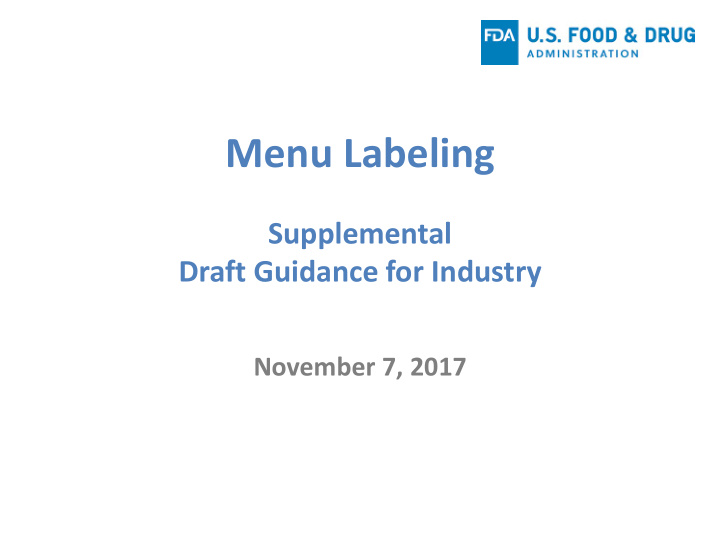



Menu Labeling Supplemental Draft Guidance for Industry November 7, 2017
Supplemental Menu Labeling Guidance • Addresses concerns raised by stakeholders regarding the implementation of the menu labeling requirements in covered establishments – Expanded and new policy interpretations – Identifies flexible and practical ways to comply with requirements • 60 day comment period for feedback • Plan to finalize the guidance quickly in time for May 7, 2018 compliance date 2 www.fda.gov
Topics Covered in Guidance • Compliance and • Calorie Disclosure for Enforcement Self-Service Foods • Determining the • Criteria for Nutrient Content for Distinguishing Standard Menu Items Between Menus and • Covered Marketing Materials Establishments • Methods for • Standard Menu Providing Calorie Items Disclosure • Alcohol Information 3
Topics Reviewing Today • Criteria for Distinguishing Menus and Marketing Materials • Calorie Disclosure for Self-service Foods • Methods for Providing Calorie Disclosure • Compliance and Enforcement 4
Criteria for Distinguishing Menus from Marketing Materials • Marketing material generally would not be considered a menu or menu board and would not require calorie declarations – Pizza coupons – Posters in store windows – Signs on gas pumps – Billboards; banners – Newspaper inserts • If the primary purpose of the materials listed above is to “entice” customers into the establishment, they would not meet criteria for a primary writing by which a customer would make an order selection 5
Example of a poster or banner in a window or on a gas pump that would not require a calorie declaration 6
Example of a marketing board that would not require calorie declarations 7
Calorie Disclosure for Self-Service Foods, Including Buffet Foods • Calories for self-service foods and foods on display can be declared in a variety of ways – The consumer needs to view the name, calorie declaration, and serving or unit of a particular menu item while selecting that item • Not required to have individual signs for each self-service food item or items on a buffet • Menus and menu boards are not required at each self-service location 8
Example of declaring calories for multiple items on a self- service salad bar or a single sign attached to the sneeze guard 9
Example of declaring calories for self-service foods on individual signs that are interchangeable and are attached to the sneeze guard by permanent placard holders 10
Example of declaring calories for multiple items at a self- 11 service buffet on a single sign hanging below the sneeze guard
Example of declaring calories for self-service foods on 12 individual signs using gel clings on the sneeze guard
Example of declaring calories for multiple self-service items on a single sign 13
Example of a grab-and-go food that meets the calorie declaration requirements using a front-of-pack calorie declaration (e.g., a sticker) that can be viewed by the consumer before purchase 14
Methods for Providing Calorie Disclosure • List calorie declarations adjacent to either the name or the price of the associated standard menu item – FDA expects that the name or price and the calorie declaration would be displayed such that the consumer can easily determine which calories are posted for each standard menu item • The menu labeling regulation does not mandate that establishments have menu boards 15
Methods for Providing Calorie Disclosure for Build-your-own Pizza • Calories may be declared in a range if there are 3 or more topping, crust, and sauce options for each size of the pizza • Topping, crust and sauce options that have the same number of calories after rounding may be grouped together 16
Example of declaring calories per slice for a build-your-own pizza using a column format 17
Example of declaring calories per slice for a build-your-own pizza using a string format 18
Additional example declaring calories for a build-your-own pizza using a string format 19
Compliance and Enforcement • FDA plans to work cooperatively with covered establishments to come into compliance with the menu labeling requirements – Education and outreach will continue, especially in the first year • If menus or menu boards are not in compliance, FDA will work flexibly and cooperatively with individual establishments making a good-faith effort to comply – We will work with an establishment on an appropriate time-frame in which to make the correction 20
Compliance and Enforcement • FDA does not intend to penalize or recommend the use of criminal penalties for minor violations • Examples of minor violations: • Inadvertently missing a calorie declaration for a standard menu item on a buffet when other items are labeled • Minor discrepancies in the type size/color contrast of calorie declarations, provided that they are readable • Minimal variations or inadvertent error that would only minimally impact the calorie declaration or other nutrition information, such as adding extra slices of pepperoni on a pizza or adding an extra dollop of ketchup on a hamburger when not typically added 21
Comments • Requesting feedback on the draft guidance for 60 days • Please provide feedback by January 8, 2018 through the docket FDA-2011-F-0172 on www.regulations.gov 22
Recommend
More recommend